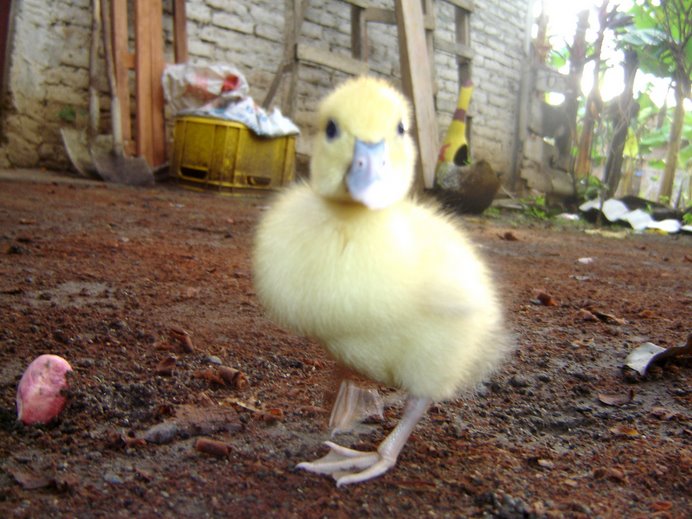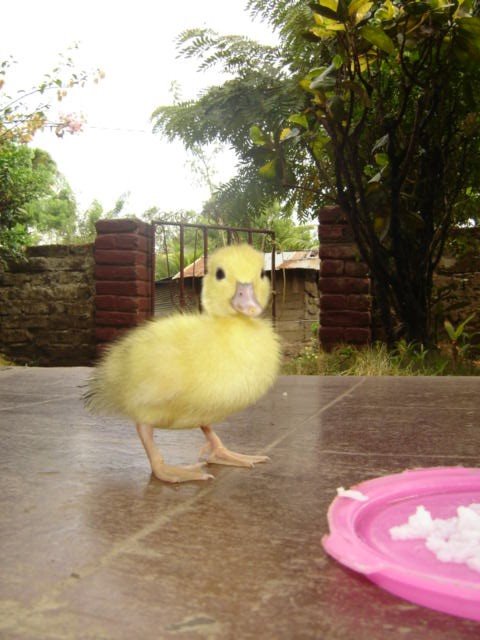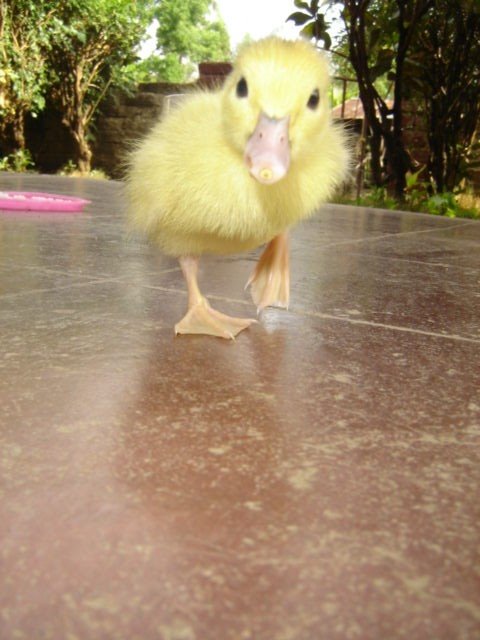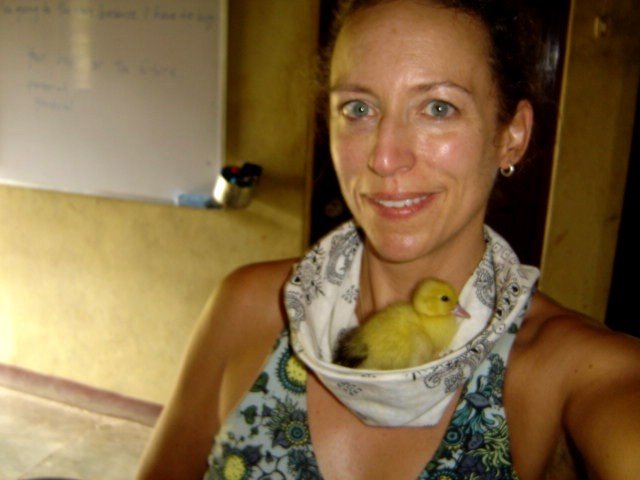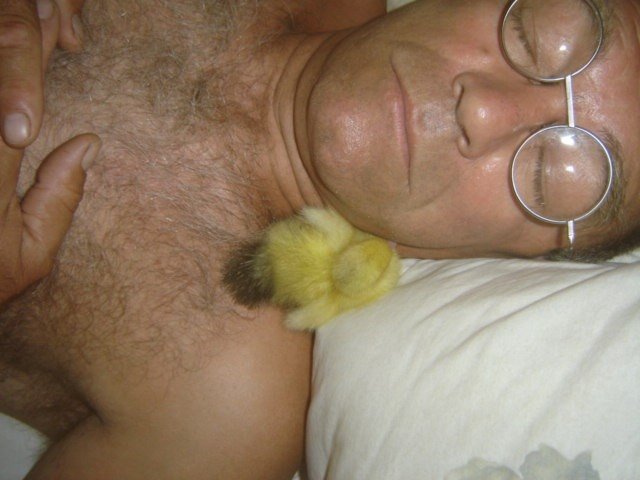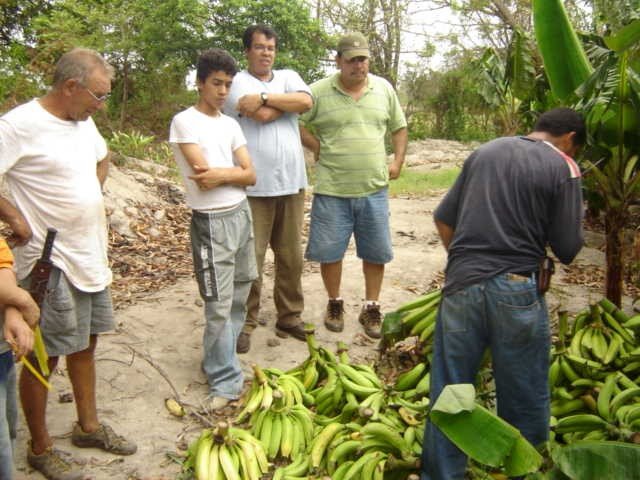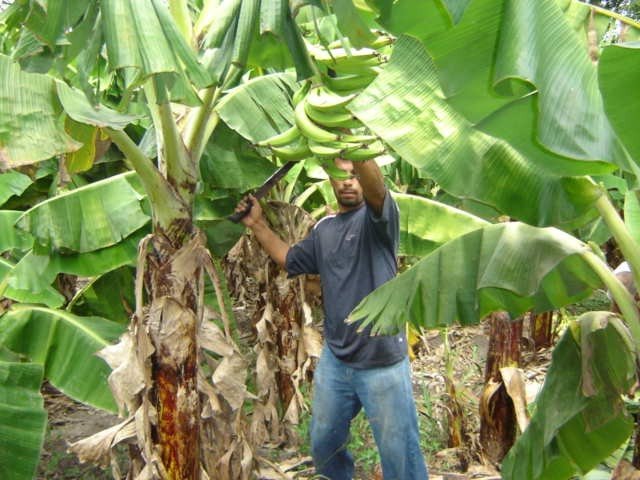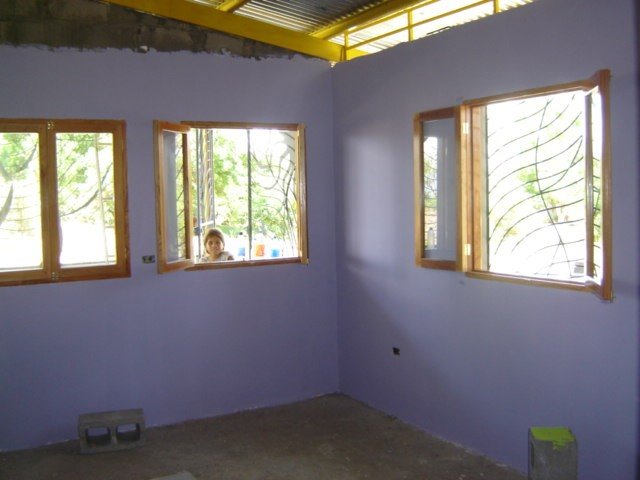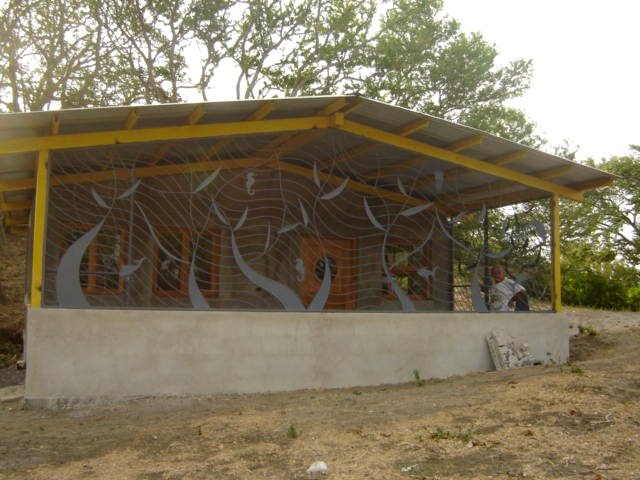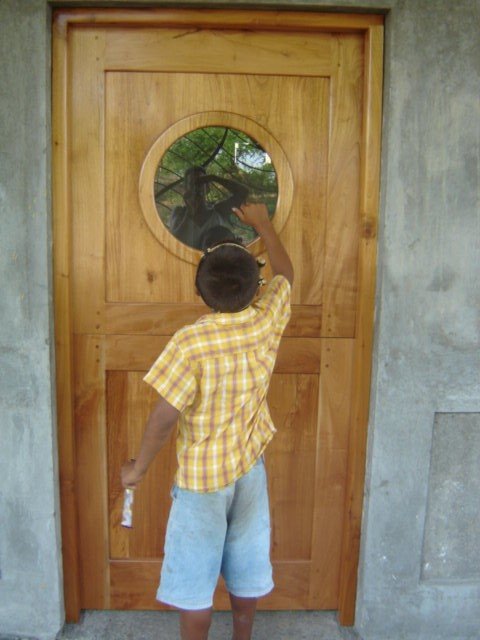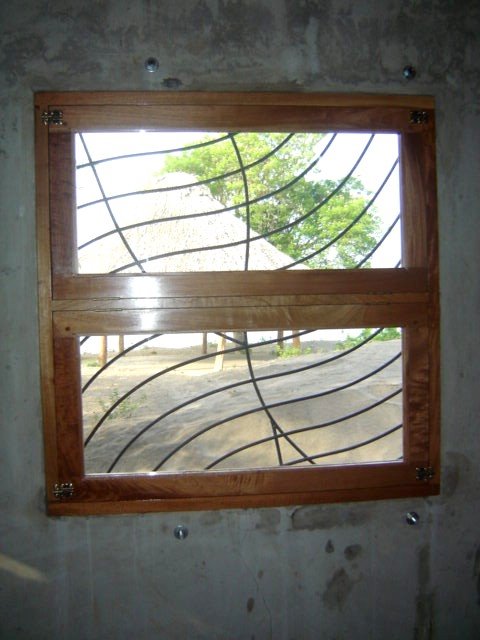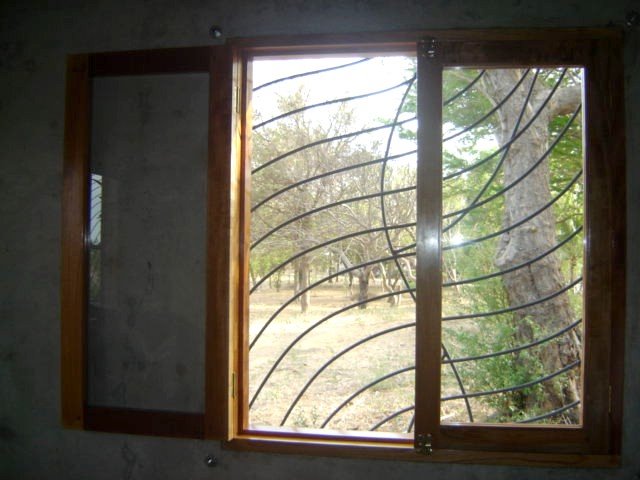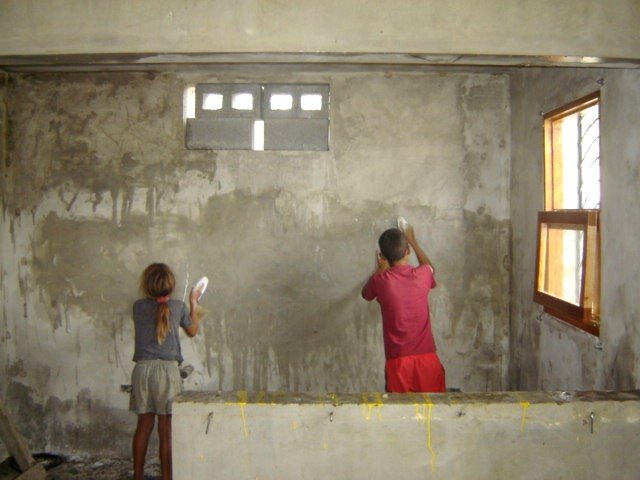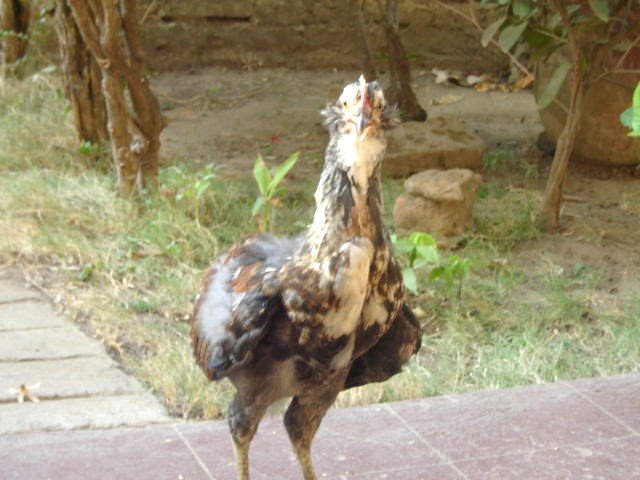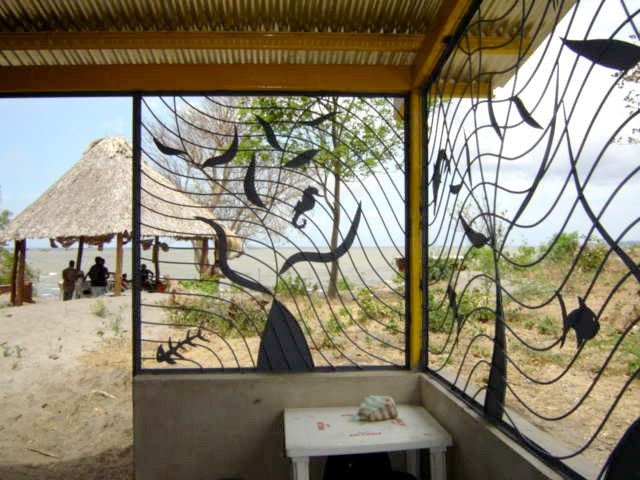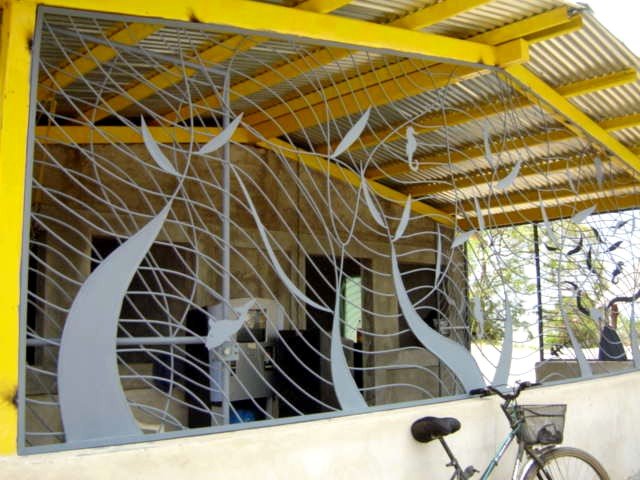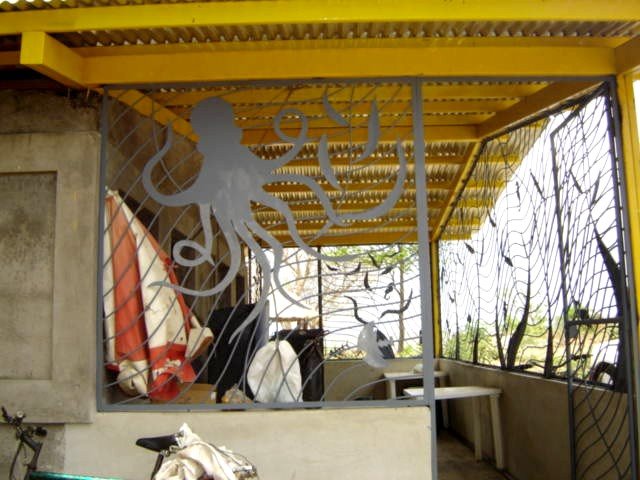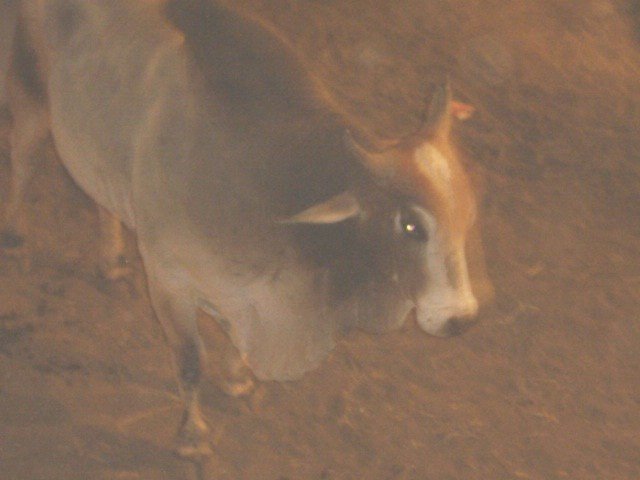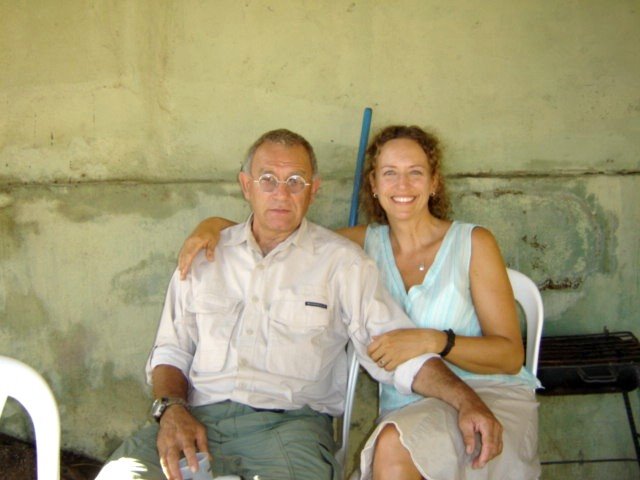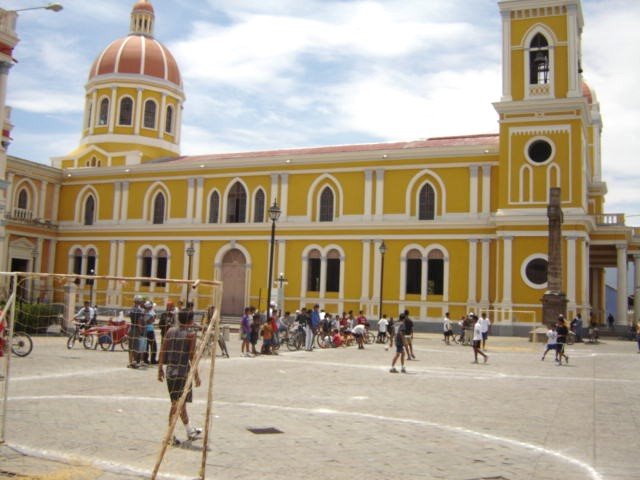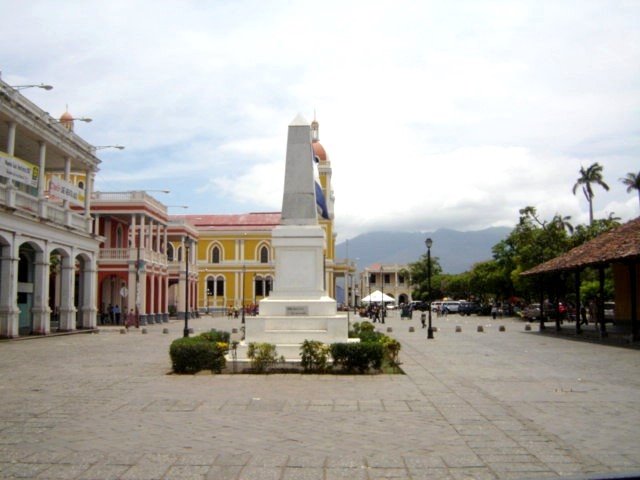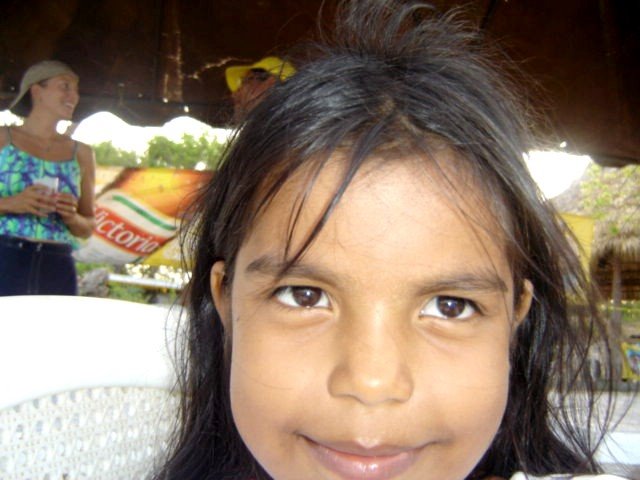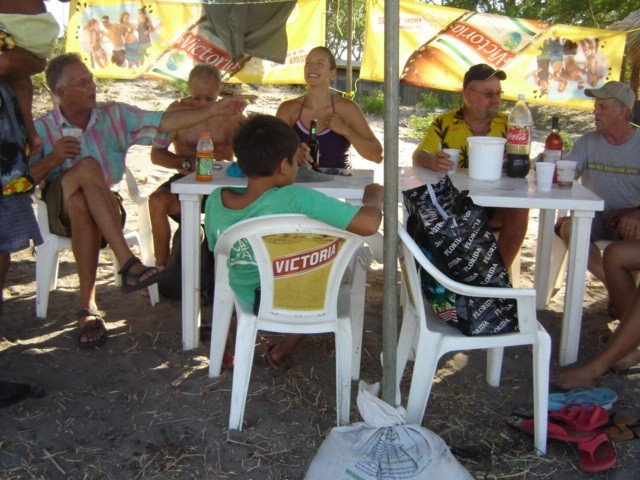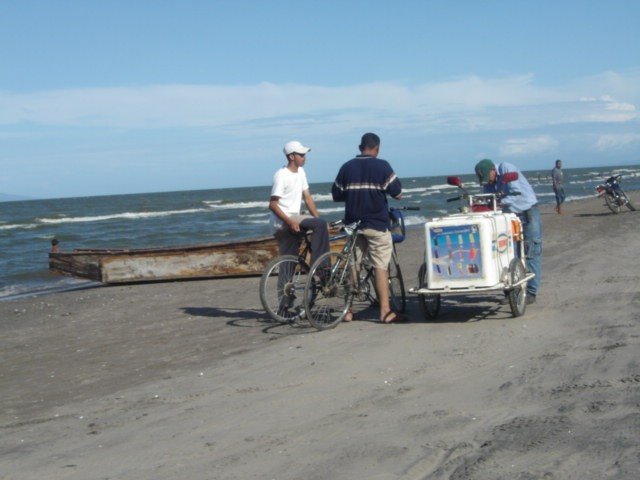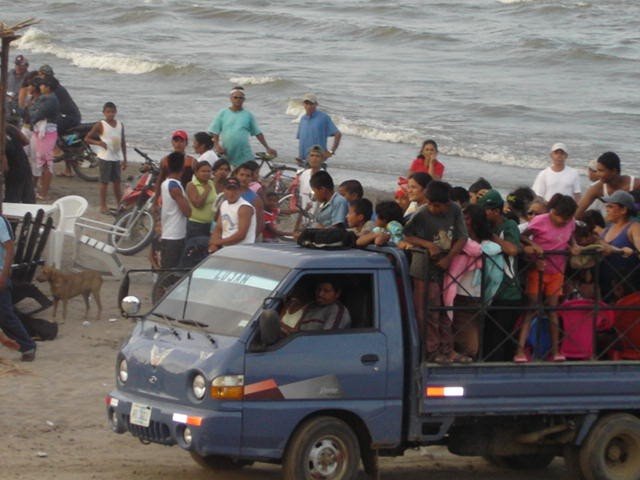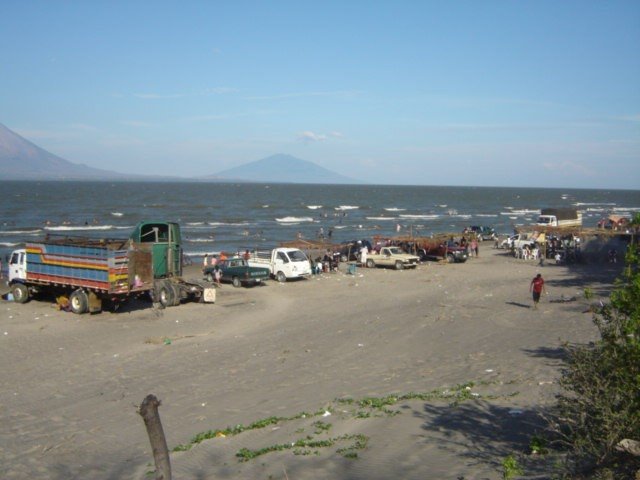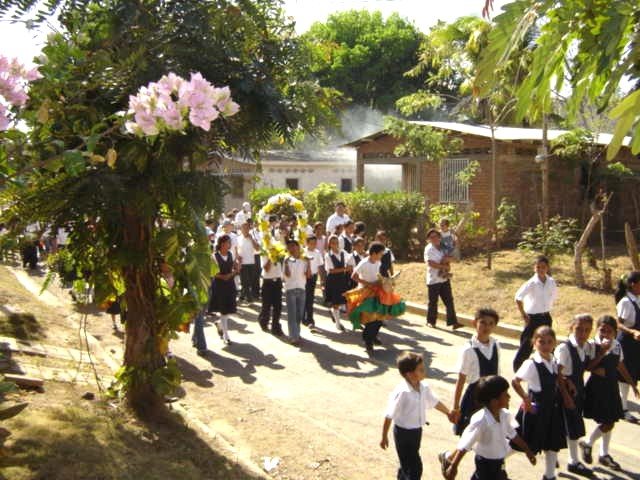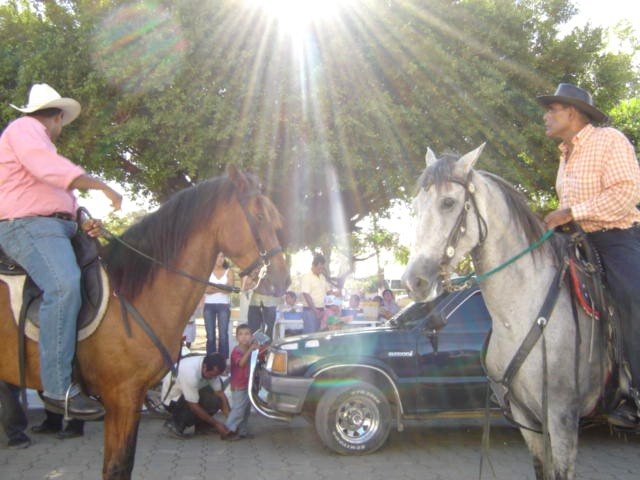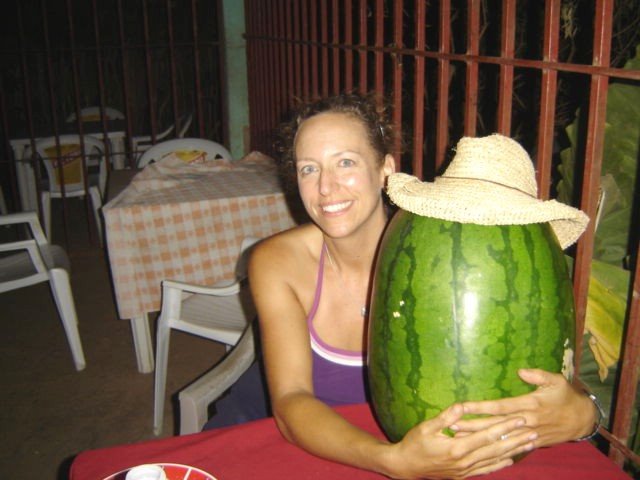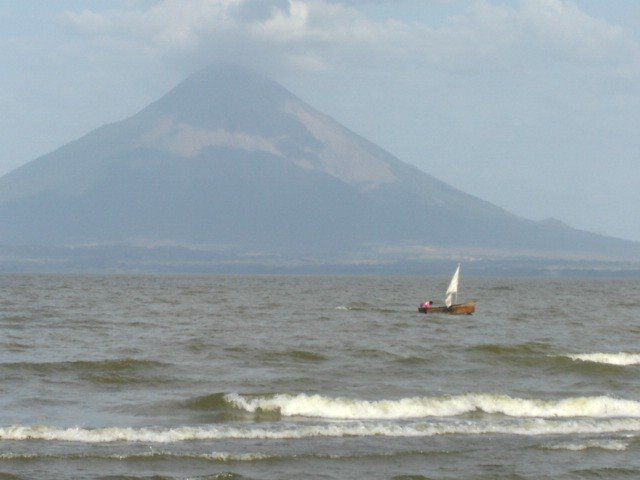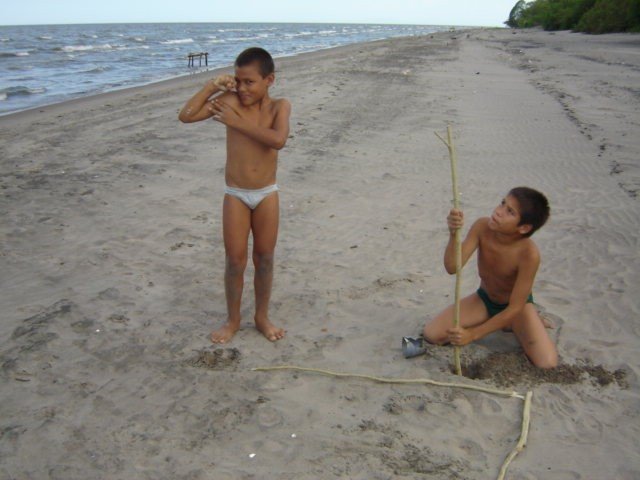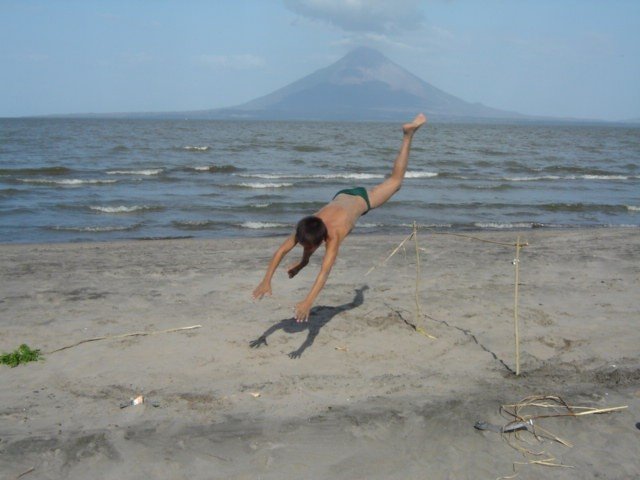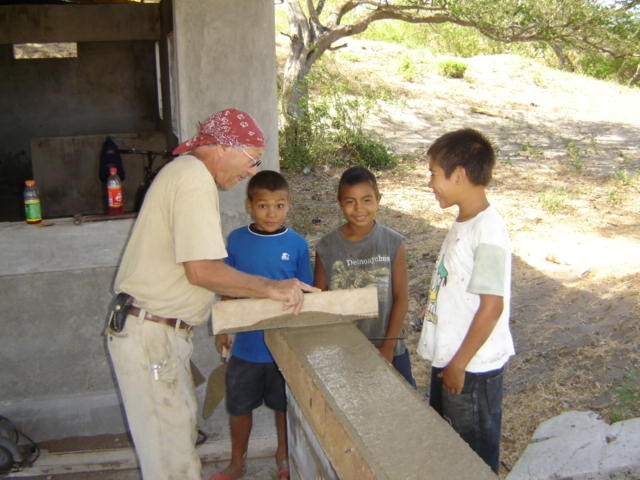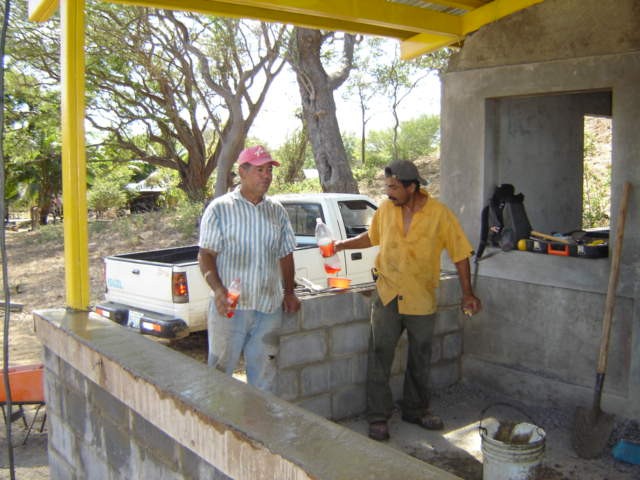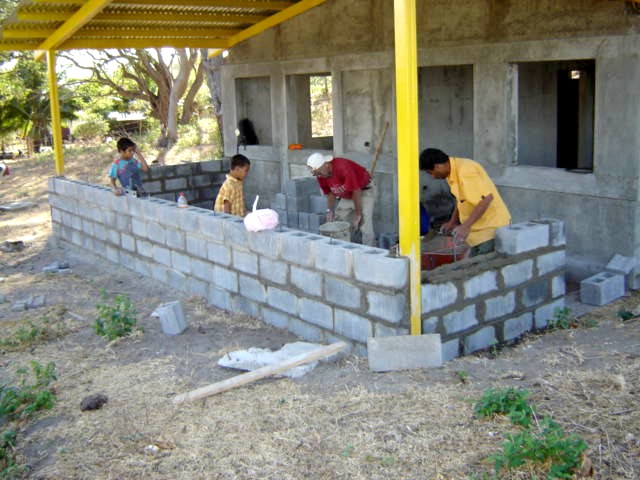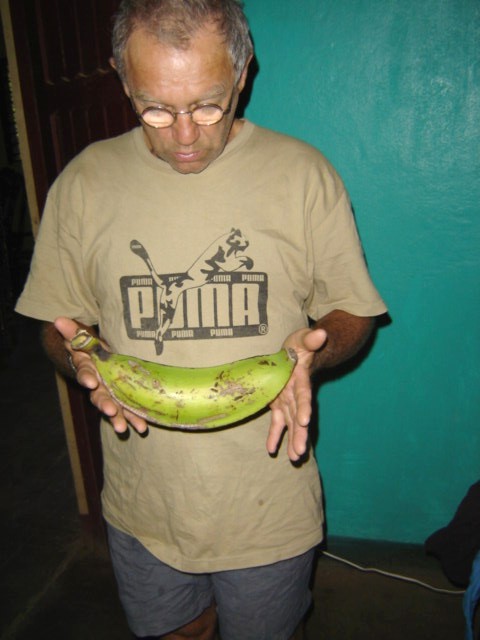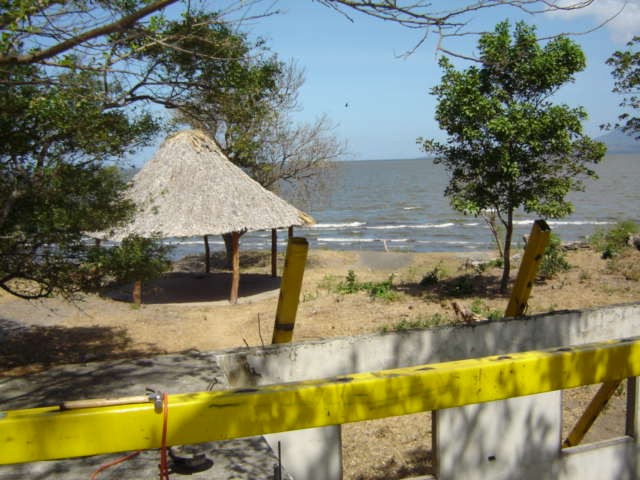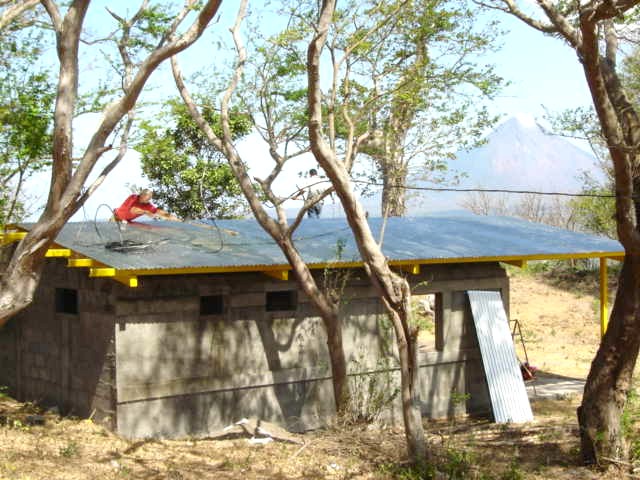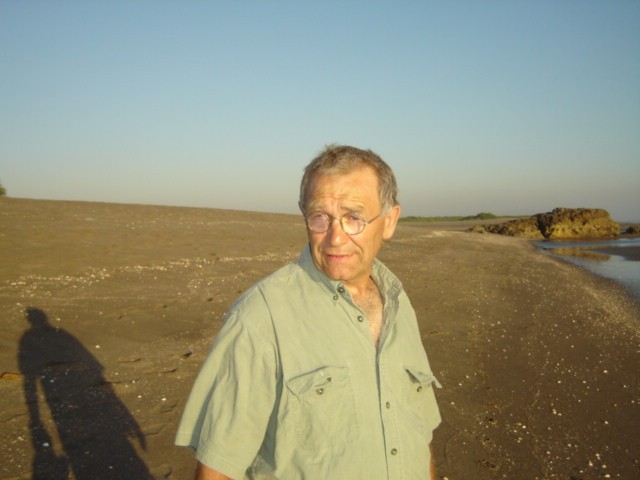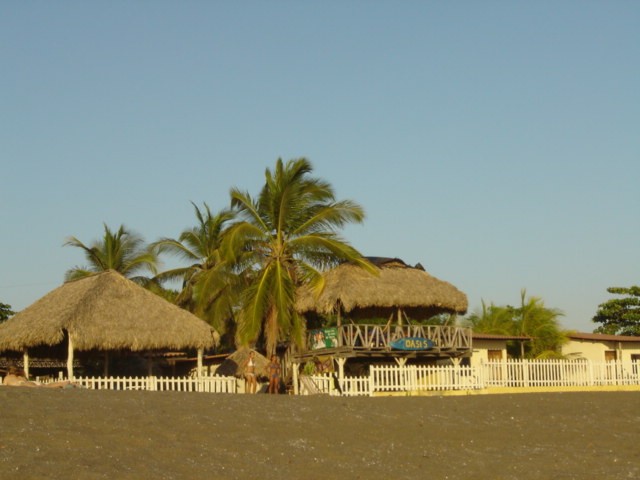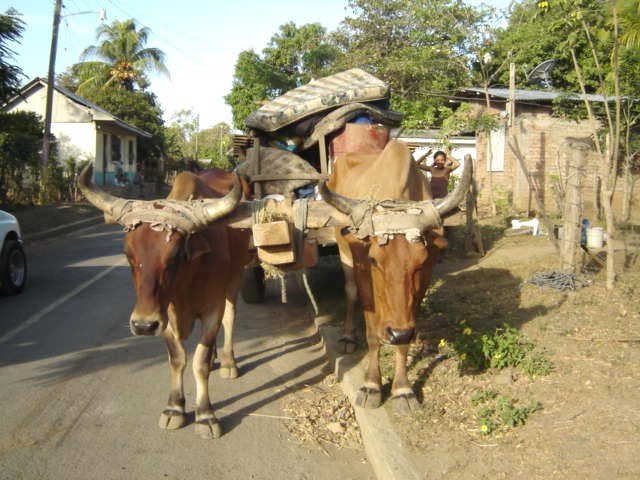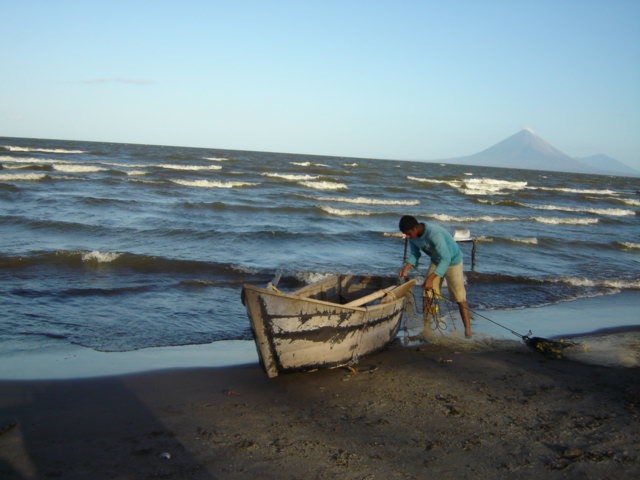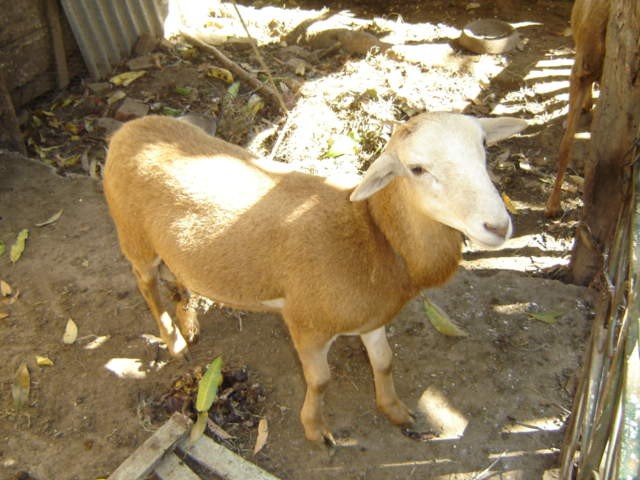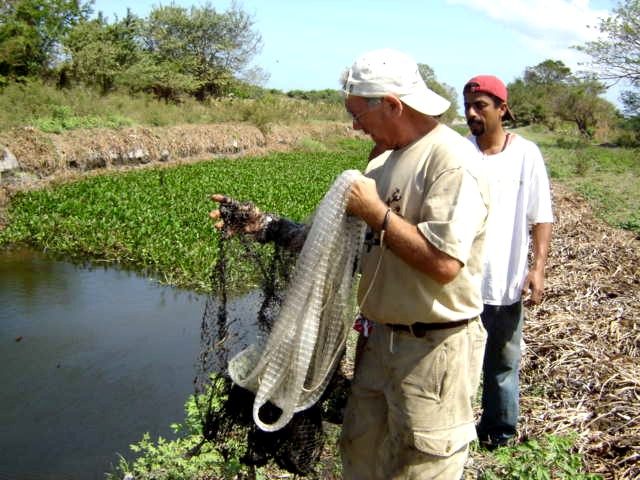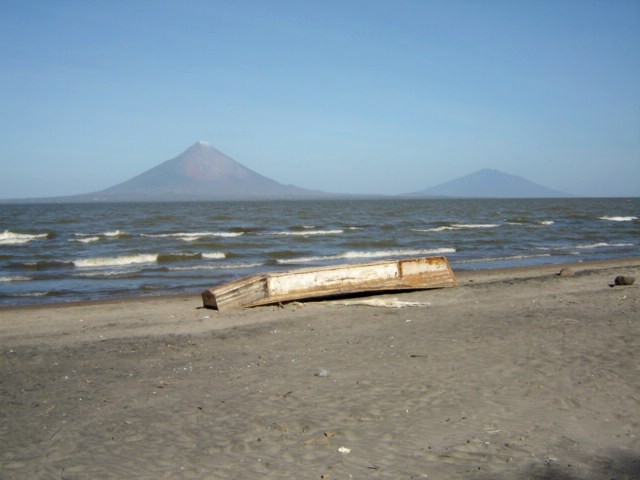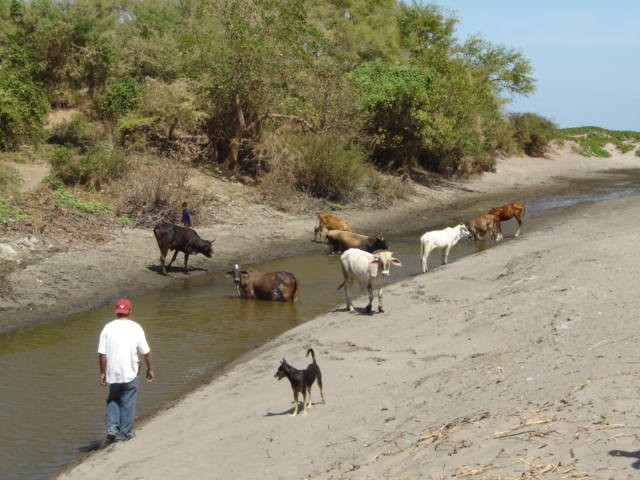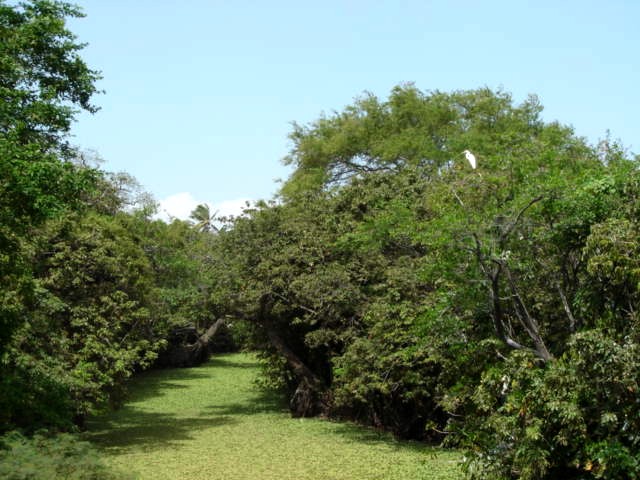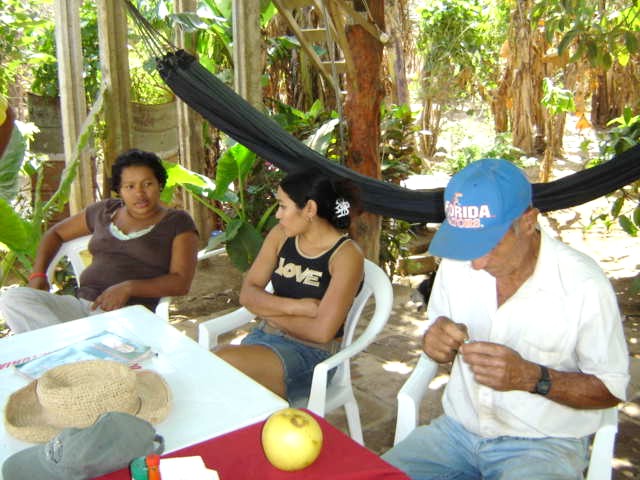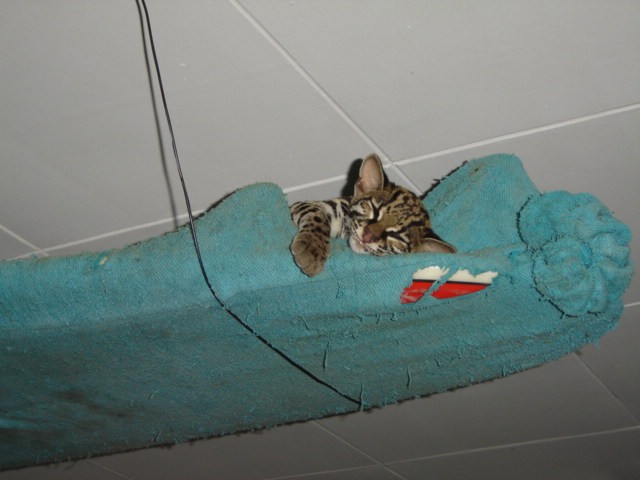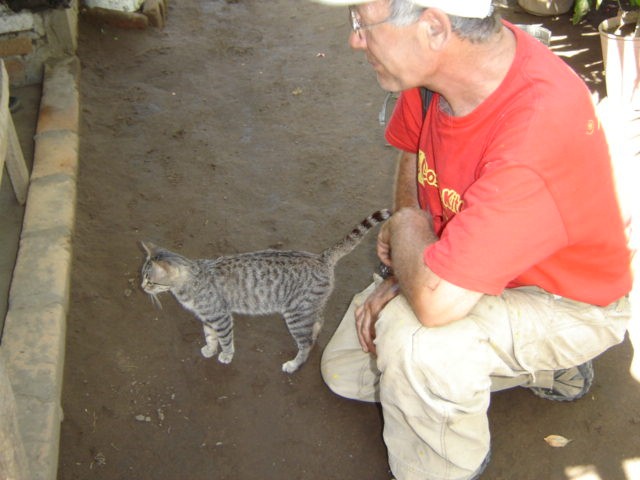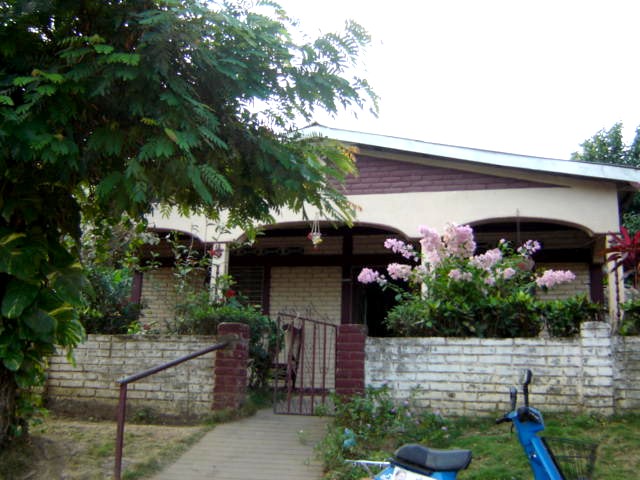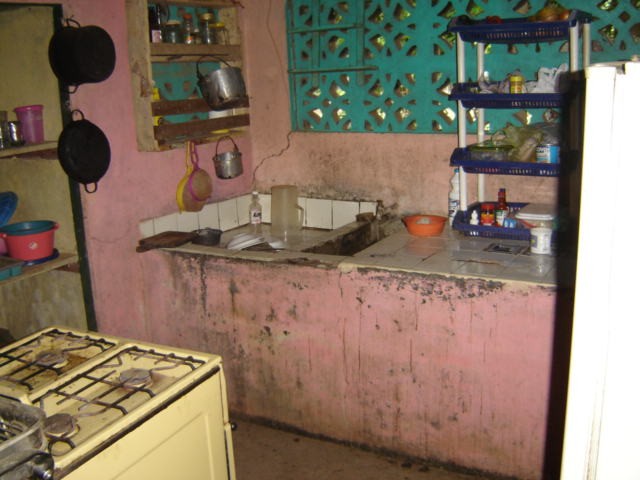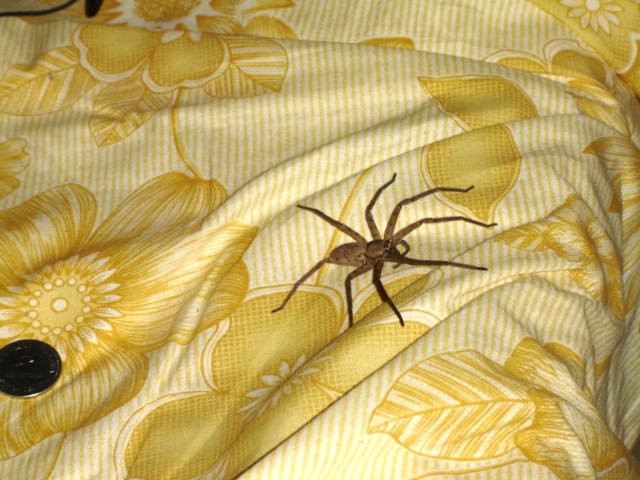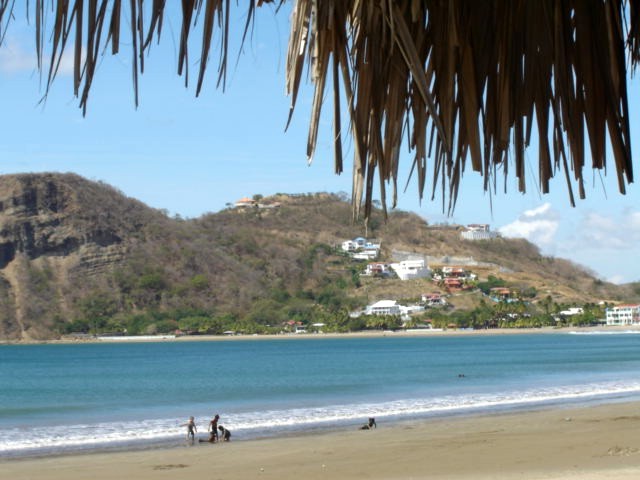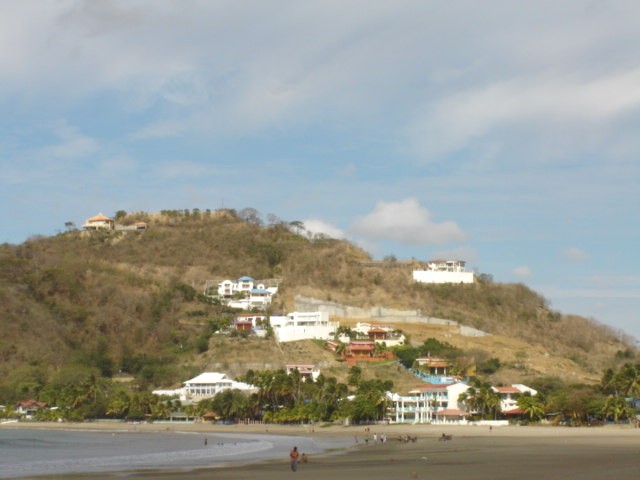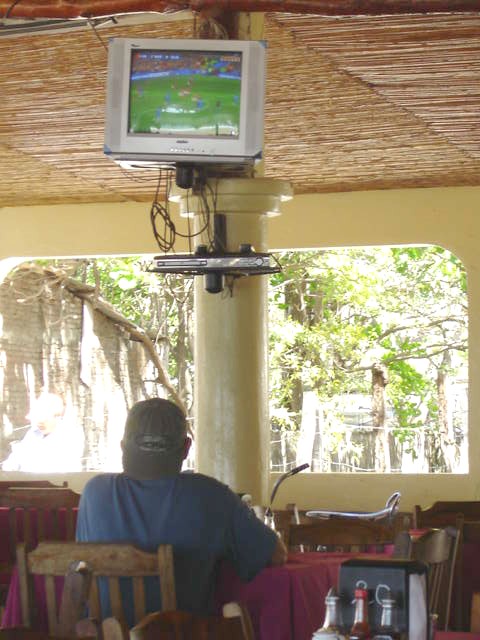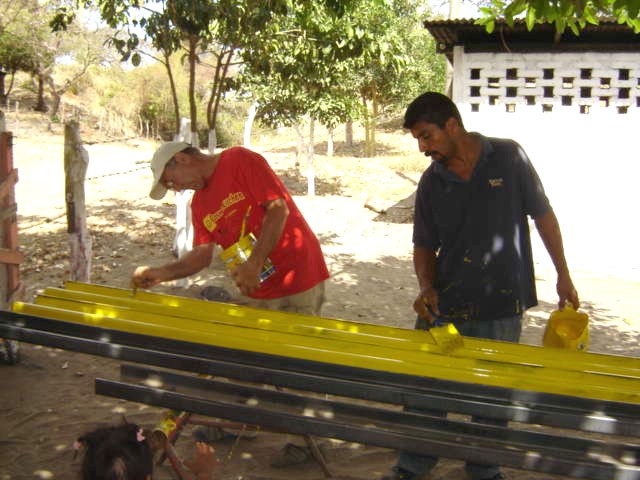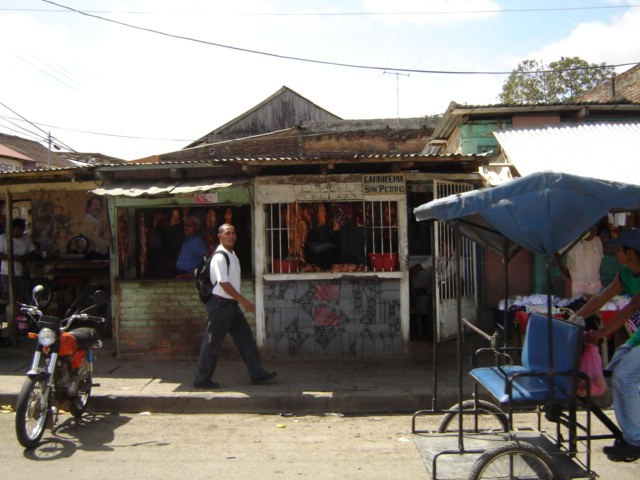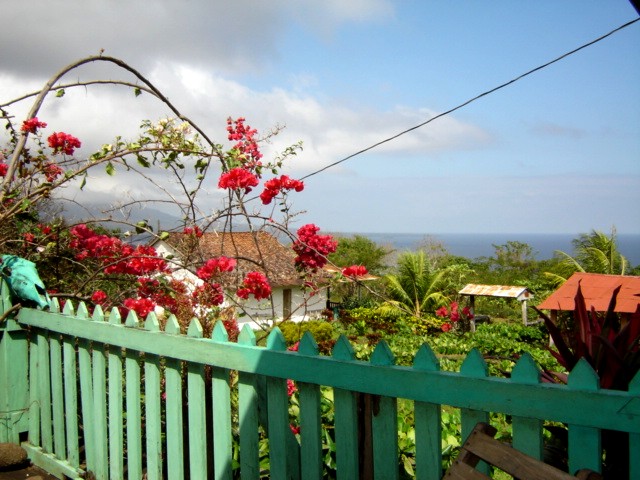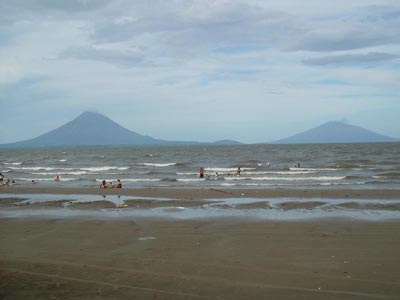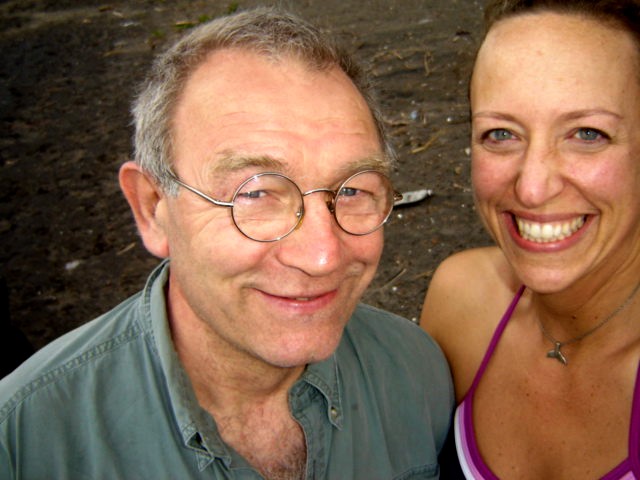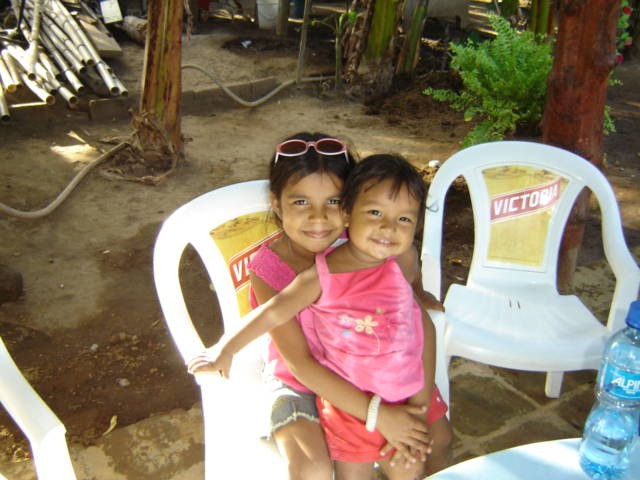After nearly two months down here, we finally ventured into Managua. In order to assure a safe and pleasant trip, Edwin came along with us, and we stayed at his oldest brother's house. But more about that in a minute. To get there—and bear in mind, it's only about 75 miles away—we had to rent a car because Edwin's truck is leaking oil and Sam's was unavailable. The car we rented, or rather, that Edwin rented, turned out to be the exact same one Sam rented for me my first trip down here, a '92 Nissan Sentra complete with spoiler and bullet hole decals, and still missing its passenger side window and seatbelts. (Well, they were technically there; the problem was there was nothing to attach them to…) But hey, for $25/day it was a bargain. The drive itself takes close to two hours due to extremely poor road conditions for over half the trip. You get going at a decent speed, up to 55mph, but after about half an hour the potholes begin and it's all over. Maybe you can hit 30mph for 100 feet…but then remember you're playing the flesh and blood video game called "driving in Nicaragua" in which every conceivable life form attempts to hurl itself into your path. Pedestrians, sober and drunk alike; bicyclists, ditto; farm animals, many of whom also appear to be drunk, particularly the cows; slow mowing horse-drawn carts; pickups loaded down with every imaginable thing from papaya to sugar cane to live chickens to farm workers; and a fairly constant stream of plastic bags blowing across the windshield. Oh, and if you do want to actually get anywhere within the calendar year, you really must master passing any and all of the above. At high speeds. While continuing to avoid the potholes.
And yet we made it to the big city unscathed, and Edwin found his way to Reinaldo's house, tucked into a small quiet neighborhood a few blocks behind the massive, sprawling Parmalat plant. (The local equivalent of Lucerne.) After nearly 30 years in Managua, Reinaldo knows his way around like a taxi driver in London, so he took over as tour guide. Our main objective was to find a new arc welding unit for Edwin as his ancient contraption had finally delivered its last spark. So began a whirlwind spin around Managua dashing from hardware store to hardware store trying to find the best machine for the best price, all before noon when everything closed. At 11:45, we found it, along with a slew of other useful odds and ends—including a pruner on a pole for Reinaldo Sr. after watching him balancing precariously on a rickety ladder last week. Back to the house to store everything safely (for Managua is a city of bandits and thieves), enjoy a delivered lunch of Nica-style fried chicken (comes with beans, rice, and spicy coleslaw), and to leave Pat with Cristofer, Reinaldo's 14 year old son, so they could watch the Barcelona vs. Real Madrid fútbol match while the rest of us: Reinaldo, Edwin, Rosario (Reinaldo's wife), Roxana (10 y.o. daughter), and the mother-in-law could all go into the city to help me find cotton sheets and pillows. Reinaldo drives a smallish pickup truck, so while the mother-in-law and I were given the places of honor, in the cab, everyone else hopped in the back. After about three minutes of being squished between the M-i-L and the door, in the heat, I started figuring out how I could join the others in the back.
They took me to a huge modern mall-like complex, comprised of hundreds upon hundreds of shops, all connected by sidewalks and pathways. There were Payless Shoestores next to microscopic kiosks selling every conceivable shade of nail polish. We did eventually find sheets, in a very odd sort of place. At first glance, it was a normal bed & bath shop, but lined up down the center of the store were several large tables piled with second hand linens. They were more or less strewn about according to size, so with the saleswoman's assistance, I eventually located top and bottom sheets and two pillow cases. While nothing matches, it all kind of works, and more importantly, they are good quality 100% cotton sheets, something I'd given up on finding in Rivas. Oh, then they weigh everything and charge you per pound. My pile came to about $15, far less than the $25 they wanted for the brightly colored 50-50 poly crap.
We then went to PriceMart, the local version of Costco (who owns them) and I got a membership card ($24/year). The place was mobbed, and I knew Pat wouldn't want to miss out, so we headed back home. After a nap and a shower, we were ready to hit the town. I'd heard about a fairly new sushi restaurant that had gotten decent reviews. While there's not too much I miss down here, sushi is definitely on the list. We piled back into the truck and set out to find it. Apparently at some point we entered Miami, because the mall in which the restaurant was located could not have felt less like Nicaragua. Beginning with a full scale parking garage (complete with strolling armed guards), and working its way up several levels of flash shops, marble stairs, fountains, sculptures, and high-end restaurants, I finally asked Reinaldo if we were still in Managua. He just laughed and said piece by piece, Nicaragua was catching up. We located the sushi place, done in the popular retro-futuristic look, and overflowing with other foreigners. Everyone made a valid attempt at figuring out the menu before ceding the job of ordering to me. Since no one had ever actually had raw fish before, and since after passing the actual sushi bar and having a look at their wares, I went easy on the traditional nigiri and focused instead on other dishes, plus a few creative rolls. The guys tried the new official cocktail of Nicaragua, the name of which I cannot recall, but which is made from Flor de Caña rum, orange juice, guajava (not to be confused with guava—it's much tarter), soda and lime. Dangerously delicious. We had sake with the meal, which aside from the very lame fish, was surprisingly tasty. Everyone learned to use chopsticks in record time, and in the end, agreed it had been the most interesting and sophisticated meal they'd ever had.
After dinner, stuffed to the gills (oh, for the five of us, including the cocktails, sake, and too much food, the bill was $78. A fortune to them, but roughly what it costs Pat and me to have a sushi splurge in Anchorage, minus the alcohol….), they took us to a huge outdoor dance place, with a vast stage and a live band playing salsa, meringue, and my personal favorite, cumbia. We ordered cold beers and took turns dancing with one another until the wee hours. The place was on the upper edge of a deep lagoon, created from a long past volcanic eruption. Across the lagoon, perched even higher, were the remains of Somoza's palatial estate, destroyed by the Sandinistas during the revolution. The next morning Reinaldo took us to see it, and it really would have been a remarkable location—atop the highest hill in Managua, with Lake Managua spanning out to the East, and the rest of city ringing the other three sides. All that remained was the concrete pad and some mangled rebar, under the shadow of an immense steel silhouette of Sandino. (See Leon blog for more on him and a picture of famed silhouette.)
After the tour, we did get to PriceMart, and it was very surreal. Edwin pushed the cart through the massive aisles as Pat and I tossed in such wonders as crunchy peanut butter, granola bars, cheddar cheese, and pistachio nuts. Best of all, I found real pillows and have been sleeping like a princess ever since.
Friday night we briefly left Nicaragua to enter a sort of Fellini-meets –David Lynchian world under the big top. Correct: we went to the circus. It's a traveling deal, covering all of Mexico and Central America, with performers from nearly every country along the way. The fliers said it started at 7, so we arrived at 7:45 and got our first glimpse of the ringmaster at 8:53. It was a traditional big top, with 10-row bleachers around the outside and VIP plastic chair seating around the ring. This is where we were, courtesy of Edwin, and at first, we actually were in the front row but then they sold about 200 more tickets and brought in as many more chairs and we wound up about four rows back. Which was ok, really, because they had this very distressed lioness who seemed entirely capable of going postal and sampling the audience.
The ringleader was about 70, with something resembling a very tired marmot on his head, and a surprising capacity for generating enthusiasm by repeating the word "Marvilloso!" over and over. In addition to the usual circus acts, the trapeze (just the one girl), the tightrope (one of the roadies branching out), the jugglers (they were quite good, although the stench of gasoline from their flying torches lingered for ages), and the contortionist (see: trapeze), we were also treated to clowns abusing actual ducks (you don't want to know, but it involved the ducks spending a lot of time in the clowns' trousers), a dancing Barney (aaaugh), and then the true star of the show, a tuxedo-clad man lip-synching to passionate Latino love songs in the manner of an absolutely brilliant drag queen. Really. He flounced about the stage, cooing and moueing and winking at all the men, waving his handkerchief at them, working the crowd into a frenzy. He got an encore. He sat on one man's knee, completely devastating the wife, clearly a 'good Christian woman', causing her to grab the baby and flee. (The man seemed rather to enjoy it however…) Then came the ostrich. One of the lovely circus girls led it twice around the ring to a lyric-less jazz version of "Whiter Shade of Pale", and then back to its spot in the corner. While it didn't garner the raves of the previous performer, the audience seemed very pleased at the opportunity to observe it first hand. Pat and I were a bit perplexed until Edwin explained there were no ostriches in Nicaragua, so the novelty factor was high.
The show ended with, I wish I were making this up, dancing Teletubbies. Children were invited into the ring to shake their fuzzy paws and the tent resounded with what I can only assume was the official Teletubbie theme song. It was very perky. Then it was all over and we went back to Edwin's to contemplate the experience over cold beers.
We have officially entered the period of saint worshipping, the weeks that lead up to Easter. The primary form of worship appears to be setting off insanely loud firecrackers ("bombas") day and night, and schoolchildren parading through the streets lugging statues of, in the case of Buenos Aires, San Jose (or St. Joe as we call him) followed by very small brass bands, heavy on the tuba. This happens roughly twice a day, at 5:30 am and 4:30 pm. Sunday was the big day of festivities, however, including an "hipica", a demonstration of dressage horses from all over SW Nicaragua. The park was mobbed, as somewhere between 30-40 beautiful horses clopped elegantly past the judges' table and around the square. Many of the riders appeared to be foreigners, but were in fact so-called "White Nicas", aka, the folks with money. A knowledgeable friend told us some of the horses were valued at up to $50K, which kind of makes you think as they trotted past the dirt floor wooden shacks along the parade route… but the square was a jubilant place all afternoon, with several of the aforementioned brass bands competing to rule the sound waves, only to be drowned out by the massive bank of speakers set up for the evening's festivities and already blasting reggaeton at top volume. When we couldn't take the noise anymore, we headed back to Edwin's to relax until the dance began. This, too, turned out to be a bit surreal, especially to Pat. The area for the dance had been cordoned off with chickenwire fencing, and there were bleachers set up inside, a stage (for the live band), and the Toña rep. with enough beer for half the city. However, the vast majority of Buenos Aireans were not inside the fence; they were perched all around the outside, watching. Inside, there were two couples, a drunk guy in white, and a handful of bored employees. And us, six of us, feeling like birds in a gilded cage. Pat, as I mentioned, found the whole thing so bizarre, the idea of paying money to be on the inside of the fence, that he eventually went and sat outside with the rest of the town, looking in. That left the five of us, and the drunk guy, to dance by ourselves, and so we did. Eventually a few more people started coming in, and by 11 when we left, the place was actually filling up. Just another night that, as some other foreigners have taken to saying, was NQR: not quite right. But as NQR has come to embody nearly every aspect of life down here for us, we've decided that it is us that must adapt, and that for all its many quirks and seeming oddities, Nicaragua is….Nicaragua.
Monday, March 19, 2007
Friday, March 9, 2007
March 9, 2007
Well as you can see from the date, I seem to have successfully gotten myself onto "Nica Time", and the whole once a week blog thing is officially history. I can't even claim travel as an excuse as we've pretty much been here…just a combination of Spanish classes, ill-timed power outages, and the ubiquitous "mañana syndrome" which pervades all aspects of life down here. An example: I mentioned in the last blog that we'd met our window makers, and that we could expect them to have everything ready to install in one month. Well the month is up this Saturday, but we've just been informed that, ahem, they've had some trouble getting the wood, and that it might be just that wee bit longer. How much longer? Well that would of course depend on them actually locating some wood, smuggling it to their shop, drying it out, and then starting the work. Why, you might be asking, would they have taken on the job, and 30% payment up front, if they didn't have the materials at hand? Good question, and from a Nica perspective, easy to answer: they needed the $ to buy the wood, and they were certain they had a reliable source to get it for them. It seems this wood, this "cedra", is very tightly controlled by the government. It is a highly-prized resource, and in addition to not wanting it over-harvested, they want to be sure of their substantial cut. Fair enough, but all it means is that a thriving black market has sprung up resulting in small trucks loaded with wood zipping about the country under the cover of night, but only when the moon is waning—or is it waxing?—because they will only harvest the trees during those few days of the month. So when will we have our windows and door? I'll keep you posted.
Pat did manage a little jaunt last weekend. He went with Edwin up to Masaya, about 50 minutes north, to help with a job for Edwin's cousin Mario. Mario runs a guaron bottling plant. Guaron, as I've mentioned before, is the very inexpensive local version of moonshine. Like rum, it’s derived from sugar cane, but there's not much of a process involved in making it, nor much time or skill. Until recently, anyone with a steel drum and some sugar cane could whip up a batch and sell it in 6oz plastic baggies for around forty cents a go. But then last year over 50 people died after drinking a homemade brew that turned out to be ethanol, and the government cracked down. Now, there are only two companies allowed to make it, and the bottling factories must be licensed and bonded. The guaron is sold in various quantities, from half-pints up to half gallons, in plastic bottles with colorful labels, and the price runs from .50-$4.00. Edwin had been called upon to weld up and install a new set of gates at the entry of the small bottling plant. Pat was fascinated by the process of bottling. It was entirely a family and friend affair, with Mario's mother and cousins handling most of the work. There were half a dozen taps coming out from one wall, each with a woman seated directly in front filling bottle after bottle. They were then placed into racks, capped by hand, then carried over to two more women who stuck on the labels. Young men packed them into boxes and loaded them onto small flatbeds, and when a truck was full, off they'd go to deliver the goods all over the Masaya-Managua area. Pat and Edwin got to go on one run, which Pat said made him feel like a rum-runner during Prohibition, slithering down dark back streets, knocking on shadowy doorways, exchanging cartons for cash, then on to the next. Of course it's all completely legal, which made it even more surreal.
On Friday night they went into Managua to stay at Edwin's oldest brother, Reinaldo's, house. After dinner they hit the town, Pat, Edwin, Reinaldo, Reinaldo's wife, and their two kids, 12 and 15. First they went to a Jamaican-themed place, which Pat said had great music but was totally dead other than a couple of desultory Gringos eying up the waitresses. After some discussion, they moved on to what they felt would be a more authentic Nicaraguan experience, and went to what Pat referred to as the Mariachi Barn. Basically, a huge open space ringed by tables and mini-bars, filled with roving bands of Mariachi musicians. But what made it interesting rather than horrifying was that every band was unique. From their outfits to their instruments, number of band members, and style of music, as each group wandered by, no two were alike. Pat's favorite included a tenor sax and bordered on the blues. Glitzy sombreros were conspicuously absent. We're planning a Managua-exploration trip soon, so perhaps I'll get a chance to experience all this firsthand—camera included.
After several weeks of listening repeatedly to the same CD being played loudly from the neighbor's stereo, I realized I was addicted to it and finally went over to ask them about the group. Although we'd been greeting each other since our arrival, this was the first overtly personal contact we'd had, so the idea of the Gringa across the street showing up on the doorstep and asking them about the music took them aback somewhat, but they rallied quickly and invited me in. Theirs is one of the simpler places on the block, made of cement block but with a dirt floor, one main room, a small side room, outdoor kitchen, outhouse, "shower" (four wooden poles wrapped by heavy black plastic to create a stall, and a five gallon bucket), and laundry. Nevertheless, the entire corner of the main room was taken up by a substantial sound system and 26" television. Priorities I guess. They showed me the CD case, and told me I could find it in the mercado in Rivas. The band is called Aventura, and I think they are either Mexican or Chicano. If I can, I'll put a link in here.
A few days back we staged the first Tolasmaida Beach Jumping competition. Pat's boys and Sofia, young Edwin's little sister, were playing around on the beach after work one day so Pat asked them who could jump the farthest. They all started flinging themselves about randomly, sand flying everywhere. Pat created an official long jump site, which brought some order to the proceedings, and it was eventually determined that Yovanni was the reigning leaper. We then moved on to the high jump, starting with Pat and me each holding up the end of a stick, but after a while, Edwin2 (as he will henceforth be called to avoid confusion) and Donald built a freestanding model from some slim but sturdy branches. Since Pat lent them his Leatherman, they had to cut many, many branches before they had the right three necessary, at which point Sofia got involved, figuring out the correct distance between poles and how best to keep them upright. All in all, an impressive bit of beach engineering. For the next half hour or so they threw themselves over the ever higher bar with abandon, but were very unhappy that on this day of all days, I'd forgotten the camera. We told them that today was practice, and the next day there'd be actual prizes as well as pictures. (We'd noticed that their beach soccer ball spent most of its time partially deflated due to a small leak, so a new one was first prize, figuring, correctly, they'd all use it anyway.) It was a lot of fun, and we were awed by their concentration and effort.
Now Pat and Edwin are creating what will surely be the most beautiful and original "verjas", metal bars, ever seen by man. Based on a sketch of mine depicting the sea, they are bringing steel bars and steel plate to life. I promise pictures in the next blog. Until then, chau.
Pat did manage a little jaunt last weekend. He went with Edwin up to Masaya, about 50 minutes north, to help with a job for Edwin's cousin Mario. Mario runs a guaron bottling plant. Guaron, as I've mentioned before, is the very inexpensive local version of moonshine. Like rum, it’s derived from sugar cane, but there's not much of a process involved in making it, nor much time or skill. Until recently, anyone with a steel drum and some sugar cane could whip up a batch and sell it in 6oz plastic baggies for around forty cents a go. But then last year over 50 people died after drinking a homemade brew that turned out to be ethanol, and the government cracked down. Now, there are only two companies allowed to make it, and the bottling factories must be licensed and bonded. The guaron is sold in various quantities, from half-pints up to half gallons, in plastic bottles with colorful labels, and the price runs from .50-$4.00. Edwin had been called upon to weld up and install a new set of gates at the entry of the small bottling plant. Pat was fascinated by the process of bottling. It was entirely a family and friend affair, with Mario's mother and cousins handling most of the work. There were half a dozen taps coming out from one wall, each with a woman seated directly in front filling bottle after bottle. They were then placed into racks, capped by hand, then carried over to two more women who stuck on the labels. Young men packed them into boxes and loaded them onto small flatbeds, and when a truck was full, off they'd go to deliver the goods all over the Masaya-Managua area. Pat and Edwin got to go on one run, which Pat said made him feel like a rum-runner during Prohibition, slithering down dark back streets, knocking on shadowy doorways, exchanging cartons for cash, then on to the next. Of course it's all completely legal, which made it even more surreal.
On Friday night they went into Managua to stay at Edwin's oldest brother, Reinaldo's, house. After dinner they hit the town, Pat, Edwin, Reinaldo, Reinaldo's wife, and their two kids, 12 and 15. First they went to a Jamaican-themed place, which Pat said had great music but was totally dead other than a couple of desultory Gringos eying up the waitresses. After some discussion, they moved on to what they felt would be a more authentic Nicaraguan experience, and went to what Pat referred to as the Mariachi Barn. Basically, a huge open space ringed by tables and mini-bars, filled with roving bands of Mariachi musicians. But what made it interesting rather than horrifying was that every band was unique. From their outfits to their instruments, number of band members, and style of music, as each group wandered by, no two were alike. Pat's favorite included a tenor sax and bordered on the blues. Glitzy sombreros were conspicuously absent. We're planning a Managua-exploration trip soon, so perhaps I'll get a chance to experience all this firsthand—camera included.
After several weeks of listening repeatedly to the same CD being played loudly from the neighbor's stereo, I realized I was addicted to it and finally went over to ask them about the group. Although we'd been greeting each other since our arrival, this was the first overtly personal contact we'd had, so the idea of the Gringa across the street showing up on the doorstep and asking them about the music took them aback somewhat, but they rallied quickly and invited me in. Theirs is one of the simpler places on the block, made of cement block but with a dirt floor, one main room, a small side room, outdoor kitchen, outhouse, "shower" (four wooden poles wrapped by heavy black plastic to create a stall, and a five gallon bucket), and laundry. Nevertheless, the entire corner of the main room was taken up by a substantial sound system and 26" television. Priorities I guess. They showed me the CD case, and told me I could find it in the mercado in Rivas. The band is called Aventura, and I think they are either Mexican or Chicano. If I can, I'll put a link in here.
A few days back we staged the first Tolasmaida Beach Jumping competition. Pat's boys and Sofia, young Edwin's little sister, were playing around on the beach after work one day so Pat asked them who could jump the farthest. They all started flinging themselves about randomly, sand flying everywhere. Pat created an official long jump site, which brought some order to the proceedings, and it was eventually determined that Yovanni was the reigning leaper. We then moved on to the high jump, starting with Pat and me each holding up the end of a stick, but after a while, Edwin2 (as he will henceforth be called to avoid confusion) and Donald built a freestanding model from some slim but sturdy branches. Since Pat lent them his Leatherman, they had to cut many, many branches before they had the right three necessary, at which point Sofia got involved, figuring out the correct distance between poles and how best to keep them upright. All in all, an impressive bit of beach engineering. For the next half hour or so they threw themselves over the ever higher bar with abandon, but were very unhappy that on this day of all days, I'd forgotten the camera. We told them that today was practice, and the next day there'd be actual prizes as well as pictures. (We'd noticed that their beach soccer ball spent most of its time partially deflated due to a small leak, so a new one was first prize, figuring, correctly, they'd all use it anyway.) It was a lot of fun, and we were awed by their concentration and effort.
Now Pat and Edwin are creating what will surely be the most beautiful and original "verjas", metal bars, ever seen by man. Based on a sketch of mine depicting the sea, they are bringing steel bars and steel plate to life. I promise pictures in the next blog. Until then, chau.
Subscribe to:
Comments (Atom)


